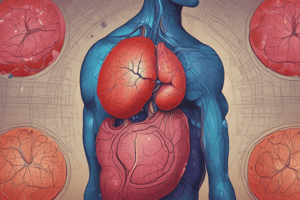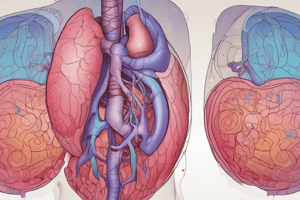Podcast
Questions and Answers
What is the primary focus of clinical pathology?
What is the primary focus of clinical pathology?
- Diagnosis of disease through surgical procedures.
- Treatment of diseases through pharmacological means.
- Diagnosis based on laboratory analysis of bodily fluids. (correct)
- Development of new surgical techniques.
Which of the following is not considered a sub-specialty of chemical pathology?
Which of the following is not considered a sub-specialty of chemical pathology?
- General or routine chemistry
- Clinical endocrinology
- Toxicology
- Clinical microbiology (correct)
What type of specimen is primarily used for clinical chemistry tests?
What type of specimen is primarily used for clinical chemistry tests?
- Red blood cells
- Platelet rich plasma
- Whole blood
- Serum (correct)
Which of these best describes therapeutic drug monitoring?
Which of these best describes therapeutic drug monitoring?
Which component is analyzed in urinalysis?
Which component is analyzed in urinalysis?
After centrifuging clotted blood, which part is collected as serum?
After centrifuging clotted blood, which part is collected as serum?
What is the primary analysis under special chemistry?
What is the primary analysis under special chemistry?
Which of the following accurately defines anatomical pathology?
Which of the following accurately defines anatomical pathology?
What is the role of inulin clearance in clinical settings?
What is the role of inulin clearance in clinical settings?
Which of the following is NOT a component of urinalysis?
Which of the following is NOT a component of urinalysis?
Which liver function test is primarily associated with cellular integrity?
Which liver function test is primarily associated with cellular integrity?
Liver function tests can be used for all the following purposes EXCEPT:
Liver function tests can be used for all the following purposes EXCEPT:
What does urinalysis help reveal regarding the body?
What does urinalysis help reveal regarding the body?
Which substances are important to measure together when assessing calcium levels?
Which substances are important to measure together when assessing calcium levels?
What is a common cause of hypercalcemia?
What is a common cause of hypercalcemia?
Which condition is least likely associated with hypocalcemia?
Which condition is least likely associated with hypocalcemia?
Which marker is NOT suitable for use in clearance studies?
Which marker is NOT suitable for use in clearance studies?
What is the formula used to determine clearance in renal function tests?
What is the formula used to determine clearance in renal function tests?
Which of the following is a requirement for a substance to be used in clearance tests?
Which of the following is a requirement for a substance to be used in clearance tests?
Which statement best describes the relationship of GFR with renal impairment?
Which statement best describes the relationship of GFR with renal impairment?
Which of the following statements about inulin is correct?
Which of the following statements about inulin is correct?
What is blood plasma primarily used to test for in chemical pathology?
What is blood plasma primarily used to test for in chemical pathology?
What process is used to prepare blood plasma from whole blood?
What process is used to prepare blood plasma from whole blood?
Which of the following is included in the Basic Metabolic Panel (BMP)?
Which of the following is included in the Basic Metabolic Panel (BMP)?
What is the primary role of electrolytes in the body?
What is the primary role of electrolytes in the body?
How much calcium in serum is typically ionized and physiologically active?
How much calcium in serum is typically ionized and physiologically active?
What is the reference range for serum total calcium levels?
What is the reference range for serum total calcium levels?
Which ions are considered medically significant electrolytes?
Which ions are considered medically significant electrolytes?
What can result from derangements in calcium metabolism?
What can result from derangements in calcium metabolism?
Which condition is associated with increased activity of alkaline phosphatase due to a bone disease?
Which condition is associated with increased activity of alkaline phosphatase due to a bone disease?
What is a physiological cause for elevated alkaline phosphatase levels?
What is a physiological cause for elevated alkaline phosphatase levels?
Which cardiac marker is specifically used to assist in diagnosing an acute myocardial infarction?
Which cardiac marker is specifically used to assist in diagnosing an acute myocardial infarction?
Which lipid component is classified as a type of cholesterol within the lipid profile?
Which lipid component is classified as a type of cholesterol within the lipid profile?
Increased alkaline phosphatase levels can indicate which of the following conditions?
Increased alkaline phosphatase levels can indicate which of the following conditions?
Flashcards
Clinical Pathology
Clinical Pathology
Medical specialty analyzing bodily fluids, tissues, and cells to diagnose diseases.
Anatomical Pathology
Anatomical Pathology
Section of clinical pathology studying tissues and cells microscopically.
Haematology
Haematology
Branch of clinical pathology focusing on blood.
Chemical Pathology
Chemical Pathology
Signup and view all the flashcards
Serum
Serum
Signup and view all the flashcards
Plasma
Plasma
Signup and view all the flashcards
Urine
Urine
Signup and view all the flashcards
Basic Metabolic Panel (BMP)
Basic Metabolic Panel (BMP)
Signup and view all the flashcards
Comprehensive Metabolic Panel (CMP)
Comprehensive Metabolic Panel (CMP)
Signup and view all the flashcards
Electrolytes
Electrolytes
Signup and view all the flashcards
Calcium
Calcium
Signup and view all the flashcards
Hypercalcemia
Hypercalcemia
Signup and view all the flashcards
Hypocalcemia
Hypocalcemia
Signup and view all the flashcards
Renal Function Tests
Renal Function Tests
Signup and view all the flashcards
Glomerular Filtration Rate (GFR)
Glomerular Filtration Rate (GFR)
Signup and view all the flashcards
Creatinine Clearance
Creatinine Clearance
Signup and view all the flashcards
Urinalysis
Urinalysis
Signup and view all the flashcards
Liver Function Tests (LFTs)
Liver Function Tests (LFTs)
Signup and view all the flashcards
Transaminases (ALT & AST)
Transaminases (ALT & AST)
Signup and view all the flashcards
Alkaline Phosphatase (ALP)
Alkaline Phosphatase (ALP)
Signup and view all the flashcards
Cardiac Markers
Cardiac Markers
Signup and view all the flashcards
Lipid Profile
Lipid Profile
Signup and view all the flashcards
Study Notes
Introduction - Clinical Pathology
- Clinical pathology is a medical specialty that analyzes bodily fluids, tissues, and cells to diagnose disease.
- The tools used in clinical pathology include clinical chemistry, haematology, and anatomical pathology.
The Sections of Clinical Pathology
- Anatomical Pathology
- Histology and Cytology
- Haematology
- Blood Bank
- Chemical Pathology
Chemical Pathology
- Chemical Pathology is the area of clinical pathology concerned with fluid analysis for diagnosis and treatment.
- Sub-specialities include:
- General or routine chemistry
- Special chemistry
- Clinical endocrinology
- Toxicology
- Therapeutic Drug Monitoring
- Urinalysis
- Fecal analysis
Types of Specimens Used in Chemical Pathology Laboratory
- Serum
- Yellow watery portion left after blood clots and cells are removed
- Plasma
- Prepared by centrifuging whole blood collected with an anticoagulant
- Used for parameters like fibrinogen, glucose, and clotting factors.
- Urine
- Analyzed for a wide range of diseases
- Other body fluids
Test Panels
- Basic Metabolic Panel (BMP)
- Includes 8 tests: sodium, potassium, chloride, bicarbonate, BUN, creatinine, glucose, calcium.
- Comprehensive Metabolic Panel (CMP)
- Includes 14 tests: all BMP tests plus total protein, albumin, ALP, ALT, AST, bilirubin.
Electrolytes
- Substances whose molecules dissociate into ions when dissolved in water.
- Medically significant electrolytes include:
- Sodium (Na)
- Potassium (K)
- Chloride (Cl)
- CO2 (in its ion form HCO3-)
Calcium Metabolism
- Calcium is the most abundant mineral in the body.
- The body maintains adequate calcium levels through a process called calcium homeostasis.
- Disruptions to this mechanism can lead to hypercalcemia or hypocalcemia.
Calcium Fractions
- Calcium in serum exists in three forms:
- Ionized (Ca2+) – physiologically active (50%)
- Protein-bound (approximately 80% to albumin) – 40%
- Complexed (citrates, phosphates etc) – 10%
Calcium Reference Intervals
- Serum total calcium reference range is 2.25 – 2.75 mmol/L.
- Serum ionized calcium reference range is 1.1 – 1.4 mmol/L.
- Serum albumin concentration should be measured alongside serum total calcium.
Causes of Hypercalcemia
- Common
- Malignant disease (e.g., some lung cancers)
- Hyperparathyroidism
- Vitamin D toxicity (excessive intake)
- Uncommon
- Renal failure
- Sarcoidosis
- Multiple myeloma
Causes of Hypocalcemia
- Hypoparathyroid
- Postoperative
- Idiopathic
- Post radiation
- Nonparathyroid
- Vitamin D deficiency
- Malabsorption
- Liver disease
- Kidney disease
- Vitamin D resistance
- PTH Resistance
- Pseudo-hypoparathyroidism
Renal Function Tests
- Used to evaluate kidney function and identify potential problems.
Biochemical Tests of Renal Function
- Glomerular Function Tests
- Measurement of GFR (clearance tests)
- Creatinine clearance
- Serum creatinine
- Serum blood urea nitrogen (BUN)
- Measurement of GFR (clearance tests)
Glomerular Filtration Rate (GFR)
- Provides an index of functioning glomeruli.
- Estimates the degree of renal impairment.
- The rate in millilitres per minute that substances are cleared from the circulation through the kidney’s glomeruli.
GFR via Clearance Studies: Criteria for Substances
- Criteria for a suitable marker for clearance studies:
- Freely filterable at the glomerular barrier
- Not reabsorbed by the tubules
- Not secreted by the tubules
- Present at a stable plasma concentration
- If exogenous - nontoxic
- Reliable assay procedure
Determination of Clearance
- Involves accurately timed urine sample plus representative blood sample(s).
- Clearance (C) = (U x V) / P
- Units: mL/min
- U: urinary concentration of substance
- V: rate of urine formation (mL/min)
- P: serum concentration of substance
GFR Determination Using Inulin
- Inulin is completely filtered at the glomerulus, but neither secreted nor reabsorbed by the tubules.
- This property makes inulin clearance a highly accurate measure of GFR.
- Inulin Clearance - potentially most accurate approach - Gold Standard.
Tubular Function Tests
- Include:
- Urinalysis
- Appearance
- Specific gravity and osmolality
- pH
- Glucose
- Protein
- Urinalysis
Urinalysis
- A physical and/or chemical examination of urine.
- Consists of various chemical and microscopic tests to screen for:
- Urinary tract infections
- Renal disease
- Diseases of other organs that result in abnormal metabolites in the urine.
- Can reveal diseases like diabetes mellitus, glomerulonephritis, and urinary tract infections.
Types of Urinalysis
- Macroscopic Examination
- Chemical Analysis (Urine Dipstick)
Liver Function Tests
- Used to:
- Detect the presence of liver disease
- Distinguish between types of liver disorders
- Gauge the extent of known liver damage
- Monitor response to treatment
Routine Liver Function Tests (LFTs)
-
Some liver function tests are associated with:
- Functionality (e.g., albumin)
- Cellular integrity (e.g., transaminase)
- Conditions linked to the biliary tract (e.g., gamma-glutamyl transferase and alkaline phosphatase)
-
Include:
- Transaminases (Alanine and Aspartate aminotransferase (ALT & AST))
- Alkaline phosphatase (ALP)
- Bilirubin (direct and total)
- Gamma glutamy transferase (GGT)
- Albumin
Alkaline Phosphatase (ALP)
- Increased activity can be caused by:
- Physiological:
- Infancy
- Puberty
- Pregnancy
- Intestinal isoenzymes
- Bone disease:
- Hyperparathyroidism
- Osteomalacia, rickets
- Paget’s disease of bone
- Osteomyelitis
- Hepatobiliary disease:
- Hepatitis
- Cholestasis
- Cirrhosis
- Others:
- Carcinoma of the bronchus
- Physiological:
Cardiac Markers Panel
- Used to diagnose myocardial infarction (heart attack).
- Includes:
- Troponin I (or T)
- Creatinine kinase (Total)
- Creatnine Kinase – MB
- Lactate dehydrogenase (LDH-1)
- Myoglobin
- Brain natriuretic peptide.
Cardiac Markers: CK-MB
- Used to assist in diagnosing acute myocardial infarction.
- Measures the blood level of CK-MB, a bound combination of two variants of the enzyme phosphocreatine kinase.
Lipid Profile
- Includes:
- Total Cholesterol
- Triglycerides
- Low Density Lipoprotein - Cholesterol (LDL-C)
- High Density Lipoprotein- Cholesterol (HDL-C)
Studying That Suits You
Use AI to generate personalized quizzes and flashcards to suit your learning preferences.




